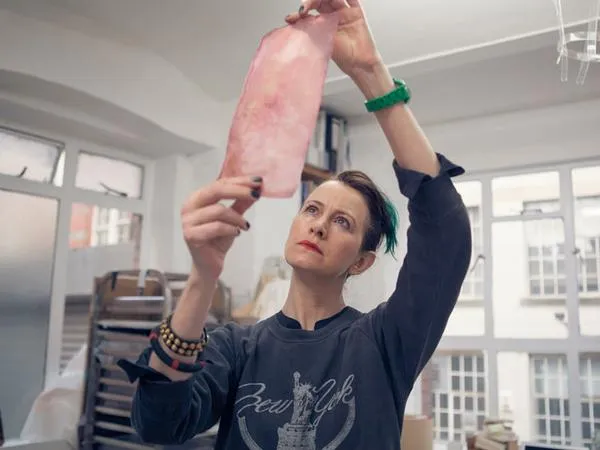Imagine you could grow your own clothes, using fermented tea, bacteria, yeast, and other microorganisms that can spin the ingredients into eco-friendly fibers. This is exactly what fashion designer Suzanne Lee pioneered. She investigated the possibility of creating clothing through the use of microbial cellulose. For this research project Lee coined the term Biocouture, which transitioned to a biocreative consultancy some years ago.
Today, she is the Creative Director of Modern Meadow Inc, an innovative New York-based team of scientists, engineers, designers and artisans developing cultured animal products and exploring new ways to create sustainable animal materials, such as lab-grown leather. Lee is also founder of Biofabricate, the leading event for the field of design, biology and technology, focused on the emerging world of grown materials.
We recently talked with Suzanne Lee about the textile industry and technology, growing leather in the lab, and the use of new alternative materials in the future of fashion.
Rather than using a plant to grow a fiber, you could use a microbe to synthesize cellulose
Biocouture, or how to grow a whole wardrobe from bacteria. How did you get the idea for this project?
Biocouture started as an academic project back in 2004. I was researching my book Fashioning The Future: tomorrow’s wardrobe and interviewing scientists and engineers to discover how science and technology might change how we think about, design and create fashion in the future. The most interesting person I spoke with was a biologist. He posited that rather than using a plant like cotton in a field to grow a fiber, you could use a microbe to synthesize cellulose and ultimately grow a garment in a vat of liquid. It blew my mind.
Transforming today’s science fiction into tomorrow’s reality. What were the challenges in the development of this project?
Well, it has still to become a reality. Sure, we successfully explored biological prototypes, but ultimately the challenge is to go beyond a low-tech artisan process to one that can be scaled industrially and produced in volume, to really offer an alternative to cheap materials derived from petrochemical or agricultural sources. The challenges there become huge. The techno economics of building a biotech infrastructure that can profitably compete with existing commodity fibers like cotton or polyester are tough. You need to be able to deliver a fiber that is either much cheaper than existing materials, highly unlikely, or it has to have some pretty advanced performance features for which people are willing to pay a premium.
 Biocouture jackets made of cellulose material
Biocouture jackets made of cellulose material
The idea of creating clothes from bacteria is unusual, what feedback and reactions did you have from people?
All depends on how you tell the story. The first thing is to be clear that the clothing is the same basic fiber as their cotton t-shirt - it’s pure cellulose - it has no bacteria in it. The clothes aren't made of bacteria, a common misunderstanding. They’re often surprised to know that their cotton t-shirt is probably GM and this isn't. Have they ever thought about where that beautiful luxury fiber silk comes from? Once they understand how eco-friendly this process is, compared to what is currently available, people are amazed, inspired and keen to either buy something for themselves or grow something for themselves.
With biology we can engineer new performance functionality and aesthetic qualities
At Modern Meadow you are developing a lab-grown leather, cultured using mammalian skin cells. A real animal product, real leather, without slaughtering. Which are the analogies, if there are, between the idea of producing in vitro meat and in vitro fashion?
At Modern Meadow we have a food program, we are not trying to grow meat in the way Mark Post has; burgers, steaks etc. What we are learning from initial research with techno chefs, which is still only early stage R&D, is that culturing cells allows us to explore new form factors and nutritional profiles. You may have seen an early food concept from Modern Meadow called a 'steak chip'. The idea is that it would be a pure protein superfood with highly tuned nutrition and traceable purity. The similar ability to create new form factors also applies to fashion. What excites me about growing materials from the bottom up is that with biology we can engineer new performance functionality and aesthetic qualities. This enables us to create vastly more sustainable and innovative materials that excite designers, consumers and environmentalists alike.
How much does it cost to produce an item of clothing made of in vitro leather? Who are the potential customers?
No-one can answer that question until they have scaled a market ready product to commercial level. But one thing is for sure, these materials, like all new technologies, will enter at the luxury end of the market before they can be scaled to sufficient volumes to bring the price down. We are just at the start of a journey for lab-grown materials that I see having real impact on the fashion and textile industry over the course of the next few decades.
It seems technological change is speeding up. Do you feel this is the case also in the fashion field? And where will this go?
Growing leather without the death of an animal is a big plan
Yes, I do think there is a greater focus on technology in fashion now than there has ever been. There are more driving forces today, both from resource-constrained material supply on the part of brands, but also from consumers who have a greater awareness than ever before. I have been researching science and tech in fashion for over 25 years. ‘Wearables’ may be finally reaching public consciousness now, but it’s a field that has been around for decades. And it’s still inhibited today by the same things: battery power, processing, flexibility, etc. This is why the focus is still, for the most part, on hard components that are embedded on a wrist worn device. We’re still a long way from having sensing, processing and display features being embedded invisibly into the fiber itself so it can be woven or knitted conventionally and thrown in a washing machine. That is smart. We’re just at the very beginning of understanding how technology and fashion might come together.
The fashion and textile industry is working to reduce its carbon footprint using sustainable materials. What are the new possibilities for a sustainable fashion industry?
The fashion and textile industry is working on multiple levels to create a more sustainable industry. It’s not just about carbon footprint, it’s about the large volumes of chemicals, sourcing raw materials, labour issues, shipping, end of life etc - a complex picture. Personally I’m excited about growing real animal leather. I think a better indication of where things are headed is the recent announcement by Bolt Threads that they can engineer yeast cells to produce spider silk using a fermentation process. This has a high chance of success as they can create high-functioning fibers in a readily scalable process.
How, in your opinion, can new technologies influence the fashion industry? What kind of aesthetics do you expect will emerge from it?
I believe the right question is: how can the fashion industry influence, inform and collaborate with new technologies? If we’re talking about building in electronic functionality, then we should be thinking around things like temporality; how can responsiveness deliver greater individual expression; shape-change; color change; programmability.
Lab-grown materials will have real impact on the fashion and textile industry
If we’re talking about biological materials, which is my main focus these days, then I think that’s something that needs to start with the familiar. So maybe initially biomimetic qualities, materials and aesthetics that are not too challenging and weird but just different enough to excite and inspire. Future generations of lab-grown products I fully expect will be living and therefore fundamentally different in both their design, production and care than what we expect today.
Do you see the employment of alternative material as a future way of producing clothes on a large scale? Or it is more applicable to high fashion?
I left microbial cellulose behind because I don’t believe the economics work at scale without significantly engineering the organism. If you’re going to do that, there are higher value materials to go after which are more likely to succeed, hence Bolt Threads growing spider-silk and Modern Meadow growing leather.
Is there the prospect of using your new materials, such as cultured leather, in different areas other than clothes?
Yes ultimately. At Modern Meadow we’re starting with fashion, but anywhere you use leather or similar materials could be a future market. It all comes down to feasibility at scale and price.
Will there be any future for plastics and metal?
Of course. And by the way, I think there’s nothing wrong with them if they are part of a closed-loop system.
What are your big plans for the future?
Growing leather without the death of an animal is a pretty big plan. But I’m also passionate to continue building the global community around biofabrication to nurture young researchers and entrepreneurs and foster biodesign innovation. We’re working on this year’s Biofabricate conference and are excited to deliver an event even better than last year!
Thanks so much, Suzanne, for sharing your work and viewpoints with us!
Featured image by Matthew Stylianou via Popular Science
More interviews: Liam Young, Bruce Sterling, Jason Silva, Arne Hendriks, Rachel Armstrong, Alexandra Daisy Ginsberg, Floris Kaayk, Chloé Rutzerveld, Nadine Bongaerts


Comments (0)
Share your thoughts and join the technology debate!
No comments yet
Be the first to share your thoughts!